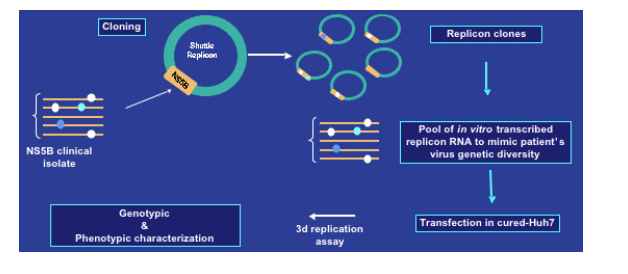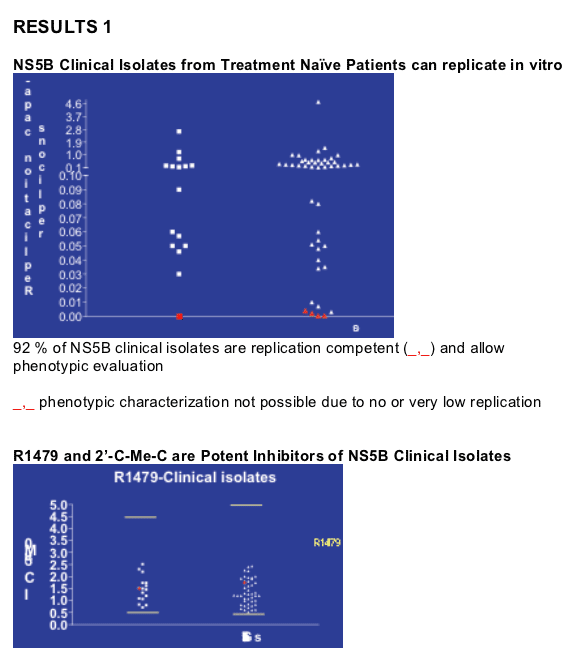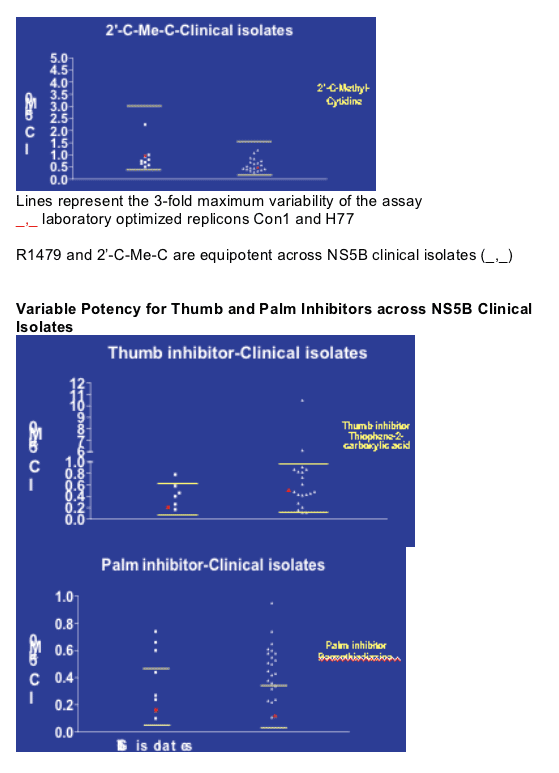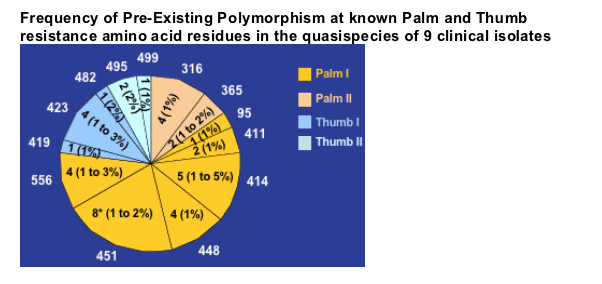 |
 |
 |
| |
R1479 (R1626), a Novel Hepatitis C Polymerase Inhibitor: Lack of Pre-Existing Resistance Mutations Supports the Observed In Vivo High Barrier to Resistance
|
| |
| |
Reported by Jules Levin
EASL, April 2007, Barcelona, Spain
S. LE POGAM, A. KOSAKA, S. HU, H. KANG, A. SESHAADRI, J. SYMONS, K. KLUMPP, N. CAMMACK and I. NAJERA
Roche Palo Alto, USA
INTRODUCTION
The Hepatitis C virus (HCV) is a +-strand RNA virus from the Flaviviridae family
R1479 (4'-Azido-Cytidine) is a potent inhibitor of replication of the laboratory optimized genotype 1b Con1 and genotype 1a H77 replicons
R1626, prodrug of R1479, has shown a maximum mean (median) HCV RNA reduction of 3.7 (4.1) log10 at 4500 mg BID dose
The high genetic heterogeneity of HCV, due to the error-prone nature of its RNA-dependent RNA polymerase, represents an opportunity for the virus to evade antiviral treatment. Selection of resistance could be therefore facilitated by the presence of minority drug resistant variants within the viral quasispecies
The aim of the study was to understand whether the inhibitory activity of HCV polymerase inhibitors is affected by the intrinsic viral genetic heterogeneity.
AUTHOR CONCLUSIONS
R1479 and 2'-C-Me-C are as active against genetically diverse NS5B isolates as against reference replicons
Non nucleoside inhibitors, benzothiadiazine and thiophene-2- carboxylic acid, showed greater variability in activity across NS5B isolates
No R1479 or 2'-C-Me-C resistance mutations in treatment naive clinical isolates were found
Palm and Thumb resistance mutations exist in treatment naive clinical isolates
The existence of natural NNI-resistance mutations among the treatment naive patients suggests a potential for faster development of clinically significant resistance for non nucleoside therapies
These findings are consistent with the lack of resistance observed in HCV infected subjects upon 14 day treatment with R1626
METHODS
HCV Phenotypic and Genotypic Characterization of NS5B Clinical Isolates
(PhenoAlto assay)

The sensitivity of subgenomic HCV replicons encoding the NS5B from 63 treatment naive HCV clinical isolates (16 GT 1b and 47 GT 1a) to R1479, 2'-C-Me-C and 2 non-nucleoside inhibitors was determined
The frequency of pre-existing mutations associated with resistance to different classes of polymerase inhibitors was determined:
-- by direct sequencing of NS5B from 63 treatment naive clinical isolates (consensus sequences)
-- by clonal sequence analysis of 764 HCV variants from 9 clinical isolates


Variable potency of Palm and Thumb inhibitors across GT 1a and 1b NS5B clinical isolates (_,_) compared to the laboratory optimized replicons Con1 and H77 (_,_)
RESULTS 2
Characterization of Genetic Diversity in the Consensus NS5B Sequences of 63 clinical isolates
No pre-existing S96T (R1479)- or S282T (2'-C-Me-C) resistance mutations were found within the 63 clinical isolates
Pre-existing polymorphism at the known Palm and Thumb NNI-resistance amino acid residues were found in 30/63 clinical isolates

In white, amino acid residues related to NNI-resistance. Number of clinical isolates containing the specified resistance mutation are indicated in %

Characterization of Quasispecies Genetic Diversity in 9 NS5B clinical isolates that do not have polymorphism at the known Palm and Thumb NNI-resistance amino acid residues in their consensus sequence
764 HCV variants from 1 GT 1b and 8 GT 1a clinical isolates were characterized
All 9 clinical isolates show the presence of polymorphism at one or multiple known NNI-resistance amino acid residues at a low frequency

In white, amino acid residues related to NNI-resistance. *Number of clinical isolates containing the specified resistance mutation. In parenthesis, range of frequency of observed mutation within each isolate (in %)

|
| |
|
 |
 |
|
|